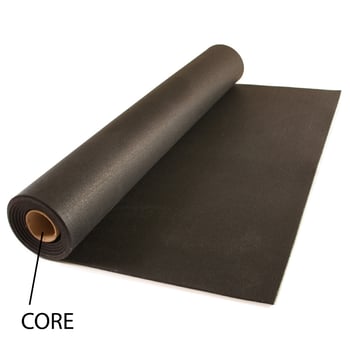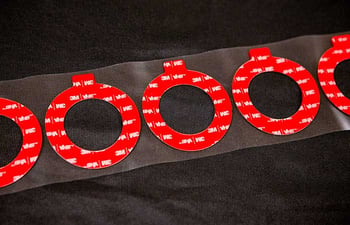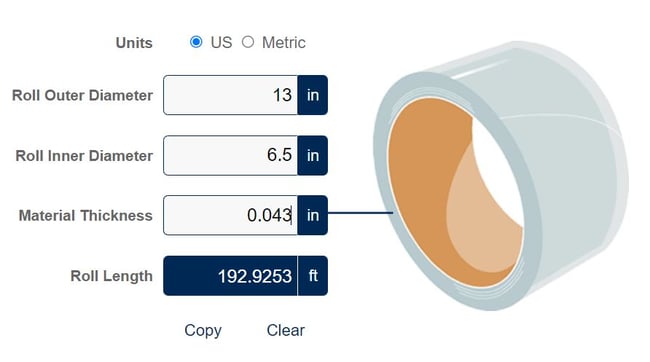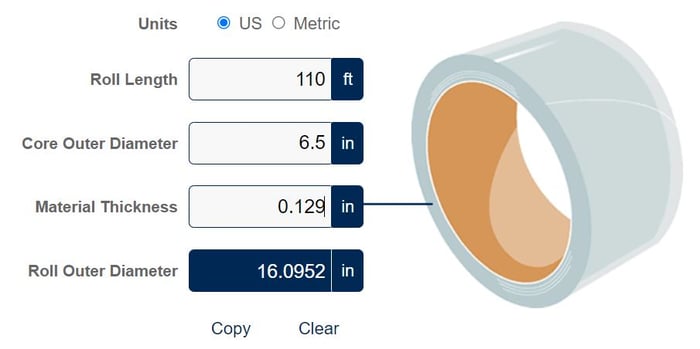Marian is a converter of thin, flexible materials. Most often, these materials are supplied to us in a large roll format, sometimes called “master rolls” or “log rolls”. The materials are typically on a hard-fiber or plastic core.
 As you can see on our Materials webpage, Marian converts a wide range of material types in a myriad of different thicknesses. These include pressure-sensitive adhesives and tapes, sponge and foam, rubber, plastic films of all sorts, filter fabrics, foils, and more.
As you can see on our Materials webpage, Marian converts a wide range of material types in a myriad of different thicknesses. These include pressure-sensitive adhesives and tapes, sponge and foam, rubber, plastic films of all sorts, filter fabrics, foils, and more.
We use many converting techniques to slit, combine and laminate, and cut the materials into precision component parts. Many of those custom-made parts are supplied to our customers on rolls.
Roll Length and Roll Diameter
In both our processes and in our customers' processes, it can be helpful to predict the length of the material on the roll (without completely unrolling it) or to predict the outer diameter of the roll if you know how long you want the material to be.
To this end, we are happy to offer two helpful calculators on our website: Roll Length Calculator, and Roll Diameter Calculator
Let's look at a few examples.
Example 1 - Calculating Roll Length
Important note before we begin...
Marian die-cutting machines are designed to keep a precise count of parts as they are manufactured. Rolls are labeled with the exact number of parts as the roll comes off the machine. However, in this example, you might like to determine approximately how many parts are left on a partially used roll. You can use the Roll Length Calculator to help estimate this.
*The calculator tools should be used for estimates, not exact measurements.*

- The die-cut part in this example is made with 3M VHB5952 acrylic foam tape.
- It is rotary die-cut to a PET liner and wound on a core with a 6.5-inch outer diameter (OD).
- The thickness of the material plus the liner is 0.043 inches thick.
- The final roll has an outer diameter of 13.0 inches.
If I enter this information into the roll length calculator, I can see that the calculated roll length is approximately 193 feet.

Calculating the Approximate Number of PArts Remaining
We know that there is a die-cut part every 6.625 inches (also known as the part index). Using this information, you can divide the roll length by the part index to calculate the remaining parts on the roll.
We estimate that there are approximately 349 parts remaining on the roll.
A word of caution: These calculators can be very precise when estimating the length of a partially used roll where each layer of the roll is tightly affixed to the layer beneath it (ie: masking tape). However, as we package die-cut parts on rolls, we cannot wind the roll tightly for fear of distorting or damaging the component. We do NOT use this method to count parts for shipment to customers. However, it can be used to calculate a general estimate.
Example 2 - Calculating Roll Diameter
Many customers who use our parts on rolls want as large of a roll as possible to minimize roll-change and machine down-time. If this is the case, it may be helpful to predict the outer diameter of a finished roll of parts to know how it might fit on your machines or equipment. It can also help to plan the packaging and handling of the rolls.

- The foam washers pictured here are manufactured with a closed-cell neoprene foam. The foam is 3.2 mm thick. It is laminated with one layer of Avery 8392 PSA, which is 0.08 mm thick.
- This is a total material thickness of 3.28 mm (0.129 in).
- The outer diameter of the core is 6.5 inches.
- The maximum length the foam material can be supplied is 110 feet.
Using the roll diameter calculator, you can determine that the diameter of the roll will be a little less than 16.1 inches.

Reiterating the word of caution - these calculators should only be used for estimates and approximate values.
We encourage you to bookmark our roll calculator tools and use them often. We also offer a range of additional resources on our website, check them out!



